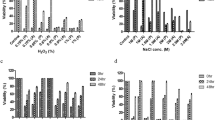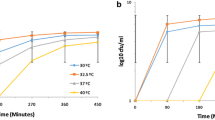Abstract
Yeast cells sense and respond to hypertonicity. Saccharomyces cerevisiae MTCC 2918 was tested for its metabolic status in 1 M NaCl by cell viability analysis, intracellular glycerol content and total antioxidant capacity. Yeast cell viability was maximum in 1 M NaCl and 24 h addition of 1 M NaCl was effective in induction of hyperosmolarity. Increased glycerol contents in cells treated with salt indicated adaptation to osmotic stress with a maximum of 240.87 ± 0.38 mg/g dry weight (DW) at 72 h. The total antioxidant status with 1 M NaCl was 9.29 ± 0.39 mM/g DW at 96 h reflecting free radical quenching to overcome stress with increasing growth period. Considering that pre-adaptation to one type of stress evoked a protective response to other stress factors, we have attempted the cross adaptation of osmotic shock to high ethanol concentrations. In effect, we observed that osmotic shock lowered the cell survival by augmentation of cell toxicity by ethanol due to stress induction during exponential phase. Glycerol accumulation to an order of 470.27 ± 0.53 mg/g DW at 48 h in 1 M NaCl and 12% ethanol indicated that both stresses culminated in membrane disruption further leading to cell burst and contributed to the stress overload.






Similar content being viewed by others
References
Albertyn J, Hohmann S, Thevelein JM, Prior BA (1994) GPD1, which encodes glycerol-3-phosphate dehydrogenase is essential for growth under osmotic stress in Saccharomyces cerevisiae, and its expression is regulated by the high-osmolarity glycerol response pathway. Mol Cell Biol 14:4135–4144
Blomberg A (2000) Metabolic surprises in Saccharomyces cerevisiae during adaptation to saline conditions: questions, some answers and a model. FEMS Microbiol Lett 182:1–8
Dake MS, Khetmalas MB, Amarapurkar SV (2011) Role of insoluble glycogen in ethanol adaptation mechanism of Saccharomyces italicus. Ind J Sci Technol 4:52–55
Gumaa KA, McLean P (1969) The pentose phosphate pathway of glucose metabolism. Enzyme profiles and transient and steady-state content of intermediates of alternative pathways of glucose metabolism in Krebs ascites cells. Biochem J 115:1009–1029
Kofli NT, Nagahisa K, Shimizu H, Shioya S (2006) Responses of different strains of Sacharomyces cerevisiae to osmotic stress. Sains Malaysia 35:9–15
Levin DE (2005) Cell wall integrity signaling in Saccharomyces cerevisiae. Microbiol Mol Biol Rev 69:262–291
Lu F, Wang Y, Bai D, Du L (2005) Adaptive response of Saccharomyces cerevisiae to hyperosmotic and oxidative stress. Process Biochem 40:3614–3618
Mager WH, Siderius M (2002) Novel insights into the osmotic stress response of yeast. FEMS Yeast Res 2:251–257
Mala JGS, Gayathiri M, Vandhana J, Rose C (2010) Molecular events in osmoadaptation of Saccharomyces cerevisiae. Yeast Newsletter 59:68–71
Nevoigt E, Stahl U (1997) Osmoregulation and glycerol metabolism in the yeast Saccharomyces cerevisiae. FEMS Microbiol Rev 21:231–241
Parmar JH, Bhartiya S, Venkatesh KV (2011) Characterization of the adaptive response and growth upon hyperosmotic shock in Saccharomyces cerevisiae. Mol Biosys 7:1138–1148
Piper PW, Talreja K, Panaretou B, Morada-Ferreira P, Byrne K, Praekelt UM, Meacock P, Recnacq M, Boucherie H (1994) Induction of major heat shock proteins of Saccharomyces cerevisiae, including plasma membrane Hsp30, by ethanol levels above a critical threshold. Microbiol 140:3031–3038
Rose C, Devamanoharan PS, Varma SD (1995) Dehydroascorbate reductase activity in bovine lens. Internat J Vit Nutr Res 65:40–44
Sharma SC (1997) A possible role of trehalose in osmotolerance and ethanol tolerance in Saccharomyces cerevisiae. FEMS Microbiol Lett 152:11–15
Stanley D, Bandara A, Fraser S, Chambers PJ, Stanley GA (2010) The ethanol stress response and ethanol tolerance of Saccharomyces cerevisiae. J Appl Microbiol 109:13–24
Trollmo C, Andre L, Blomberg A, Adler L (1988) Physiological overlap between osmotolerance and thermotolerance in Sacharomyces cerevisiae. FEMS Microbiol Lett 56:321–326
Zi Z, Liebermeister W, Klipp E (2010) A quantitative study of the Hog1 MAPK response to fluctuating osmotic stress in Saccharomyces cerevisiae. PloS One 5:1–13
Acknowledgments
The financial assistance extended by the Council of Scientific and Industrial Research (CSIR), India, to the first author Dr. J. Geraldine Sandana Mala is gratefully acknowledged.
Author information
Authors and Affiliations
Corresponding author
Rights and permissions
About this article
Cite this article
John, G.S.M., Gayathiri, M., Rose, C. et al. Osmotic Shock Augments Ethanol Stress in Saccharomyces cerevisiae MTCC 2918. Curr Microbiol 64, 100–105 (2012). https://doi.org/10.1007/s00284-011-0036-9
Received:
Accepted:
Published:
Issue Date:
DOI: https://doi.org/10.1007/s00284-011-0036-9




